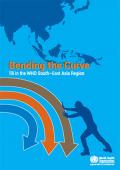Publications - Released in 2016
The WHO South-East Asia Region is home to 26% of the world's population and yet accounts for 41% of the global burden of tuberculosis (TB) incidence. In 2014, there was an estimated TB prevalence of 5.4 million and an incidence of 4 million. About 460,000 people died of the disease that year in the Region. The Region is also home to around 30% of the estimated global cases of multidrug-resistant (MDR) TB. Given the Region's outsized TB disease burden, not doing enough and not doing it fast enough is simply unacceptable. Delays in addressing the disease mean not only perpetuating the disease but also the associated suffering and resultant deaths.
WHO's Global End TB Strategy was endorsed by the World Health Assembly in Geneva in May 2014. The Strategy calls for an 80% reduction in TB incidence by 2030 and a reduction of 90% by 2035. The Strategy is based on principles of government stewardship and accountability; strong coalition with civil society organizations and communities; protection and promotion of human rights, ethics, and equity. All Member States need to adopt this bold and comprehensive Strategy to end TB.
Downloads
Organizations
- World Health Organization (WHO)






